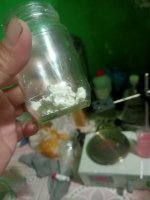G.Patton
Expert
- Joined
- Jul 5, 2021
- Messages
- 2,811
- Solutions
- 3
- Reaction score
- 3,089
- Points
- 113
- Deals
- 1
Introduction
Amphetamine can be obtained in a 30% yield in a one-step synthesis by refluxing phenylacetone in ethanol with ammonia, aluminium grit, and a small quantity of mercuric chloride. By trying out this reaction procedure for amphetamine, it was found that the yield of the reaction was not as high as for Pervitin (30% and 70%, respectively). However, the easiness of the procedure makes this method worthwhile. It's the simplest way to obtain amphetamine sulphate from P2P. Another way you can learn in Synthesis of Dextroamphetamine from P2P with (S)-(−)-α-Methylbenzylamine topic.
Equipment and glassware:
- 2 L Round bottom flask;
- Magnetic stirrer with heating plate;
- Water bath;
- Glass rod and spatula;
- Laboratory scale (0.01-100 g is suitable) [depends on synthesis load];
- Measuring cylinders 100 and 500 mL;
- 100 mL x3; 250 mL x3; 500 mL x3 Beakers;
- 1 L Separatory funnel;
- Boiling chips;
- Buchner flask and funnel [Schott filter may be used for small quantities];
- Pasteur pipette.
Reagents:
- 40 g, 0.3 mole Phenylacetone (P2P) [CAS: 103-79-7];
- 200 mL Ethanol (EtOH) 96-98 %
- 200 mL 25 % Ammonia alc. (NH4OH);
- 40 g, 1.5 moles Al-grit;
- 0.3 g,1 mmol Mercury chloride (2) (HgCl2);
- ~200 mL Distilled water;
- 120 g Potassium hydroxide (KOH);
- ~450 mL Diethyl ether (Et2O);
- ~ 200 mL Hydrochloric acid 20 % (HCl) aq. solution;
- ~ 200 g Sodium sulfate (Na2SO4);
- ~30 mL Sulfuric acid conc. 98%.
Boiling Point (free base): 200-203 °C at 760 mm Hg;
Melting Point: 280-281 °C;
Molecular Weight: 368.5 g/mol;
Density: 0.936 g/mL;
CAS Number: 60-13-9.
Procedure
A mixture of 40 g (0.3 mole) phenylacetone, 200 mL ethanol, 200 mL 25 % ammonia, 40 g (1.5 mole) Al-grit and 0.3 g (1 mmol) HgCl2 is warmed with vigorous stirring in 2 L round bottom flask with reflux condenser until reaction takes place, after which warming is stopped immediately. Cooling should be applied if the reaction becomes too violent. When the violence of the reaction has diminished, the mixture is refluxed with vigorous stirring for about 2 h, concentrated in vacuo to 200 mL and poured into ice water, alkalinized with 120 g KOH, and extracted with ether (100 mL x 3). The extractions are treated with 20 % HCl, the resulting water layer alkalinized and extracted with 150 mL ether. The organic layer is dried over Na2SO4, the ether evaporated, and the residue distilled in vacuo. Yield: 12.5 g (30 %).
Preparation of amphetamine sulfate by addition of sulfuric acid drop-wise is yielded 96-98 % product with a purity of 99.2-99.8 % (USP grade), which was filtered as white powder on the Buchner flask and funnel and air dried. Here and here you can find video and photo-manuals of acidifying procedures respectively.
Last edited by a moderator:

